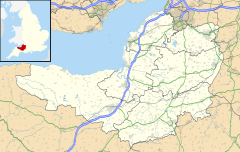Long Ashton
| Long Ashton | |
|---|---|
 All Saints church and the Angel Inn, Long Ashton |
|
| Long Ashton shown within Somerset | |
| Population | 6,044 (2011) |
| OS grid reference | ST545705 |
| Unitary authority | |
| Ceremonial county | |
| Region | |
| Country | England |
| Sovereign state | United Kingdom |
| Post town | BRISTOL |
| Postcode district | BS41 |
| Dialling code | 01275 |
| Police | Avon and Somerset |
| Fire | Avon |
| Ambulance | South Western |
| EU Parliament | South West England |
| UK Parliament | |
Long Ashton is a village and civil parish in Somerset, England. It falls within the Unitary Authority of North Somerset, just outside the boundary of city of Bristol. The parish has a population of 6,044. The parish includes the hamlet of Yanley, and the residential area of Leigh Woods (although most of the woods themselves are in the neighbouring parish of Abbots Leigh).
The village is built on the south-facing slopes of a valley running from east to west, and on the old road from Bristol to Weston-super-Mare.
Prehistoric and Roman artefacts have been found in the area, at the site of the Gatcombe Roman Settlement, but the village originated in Saxon times. The Domesday Book records it as Estune (the place by the ash tree) and, afterwards, it was granted to Bishop Geoffrey of Constances. The village was normally just called Ashton up to the mid 19th century. It acquired the prefix "Long" from the fact that it straggles along the main road for nearly 2 miles.
The parish was part of the hundred of Hartcliffe.
The manor house dates to 1265 and, in the late 15th century shares in the estate were purchased by Richard Amerike (one of the possible sources of the name America). Previously the manor had passed through the hands of the Lyons, Choke and finally Smyth families. By 1603 the Smyths had become the principal landowners in the parish and were lords of Long Ashton for four centuries—the estate finally being sold in 1946. A deserted medieval farmstead and part of a Romano-British field system 400 metres (1,300 ft) north of Fenswood Farm has been identified including three enclosures which are thought to be the foundations of buildings, each surrounded by a rubble banks.
...
Wikipedia

